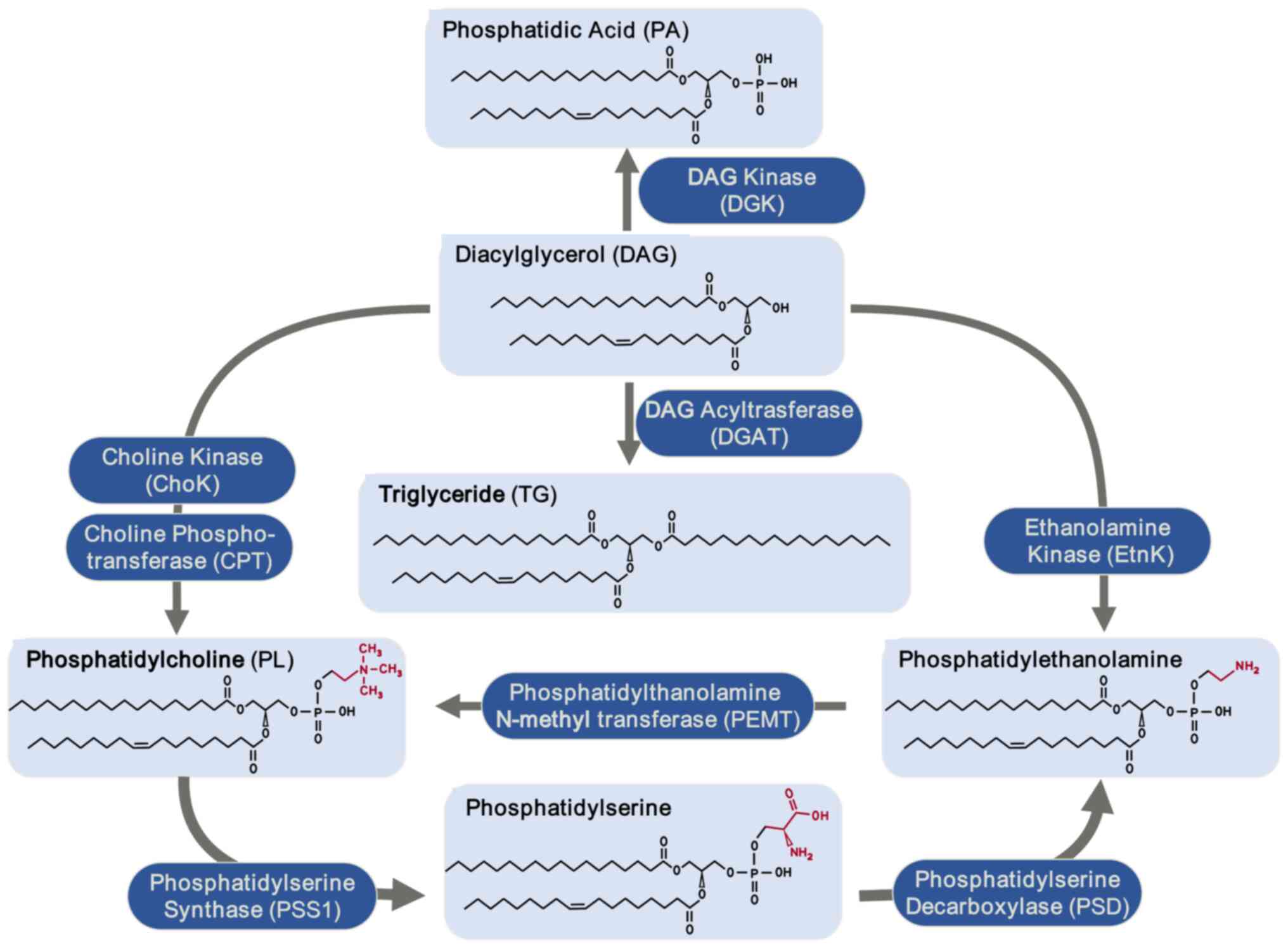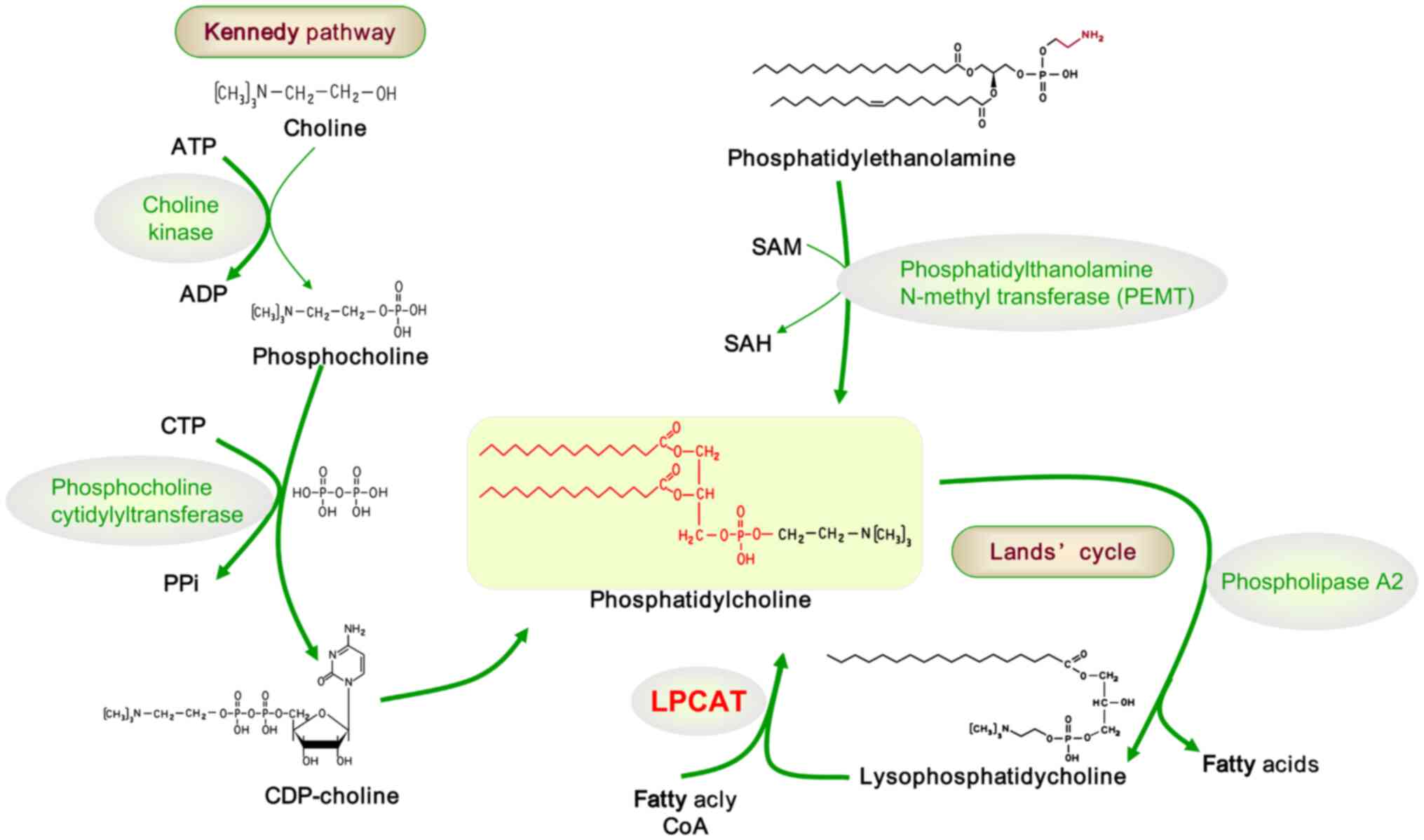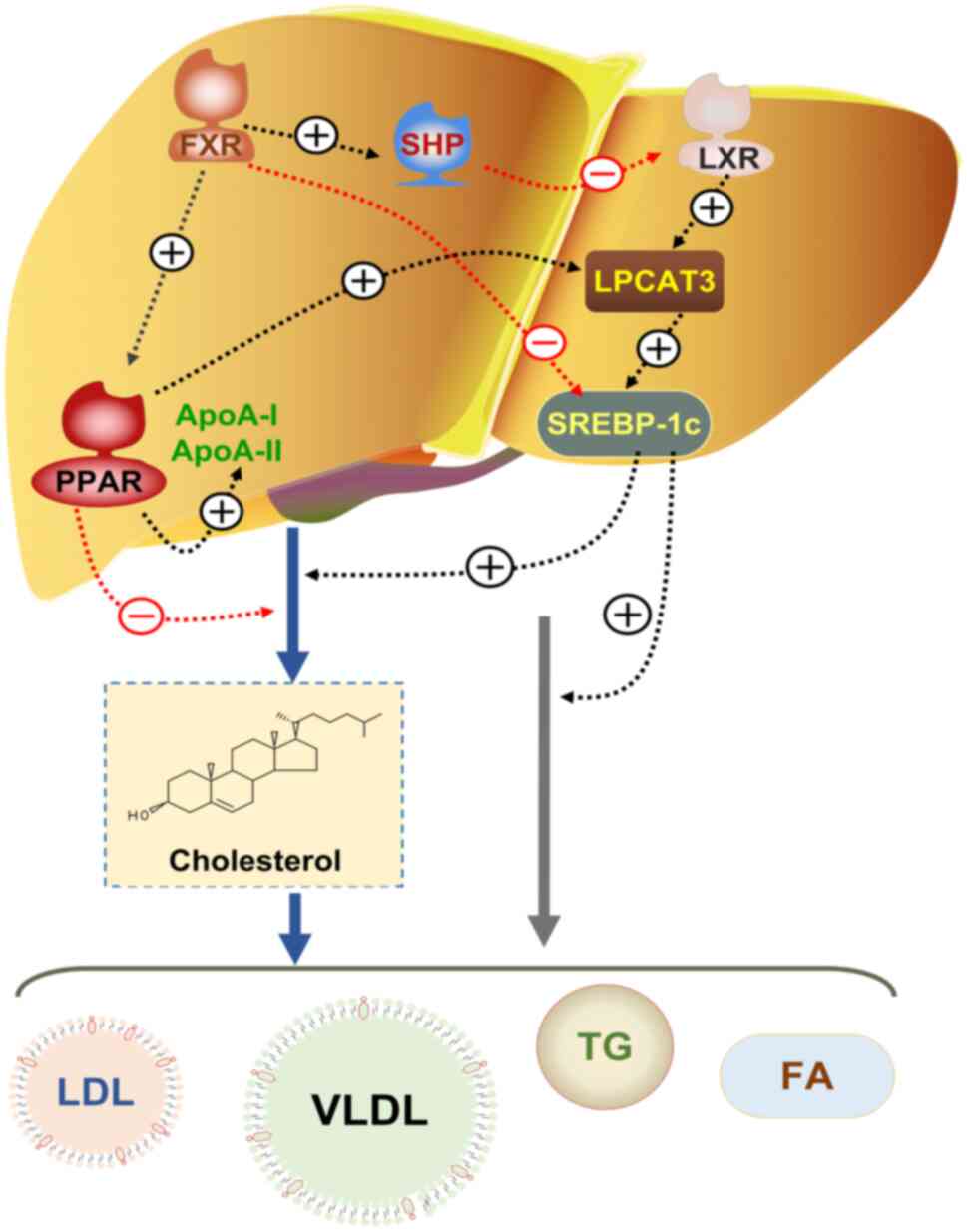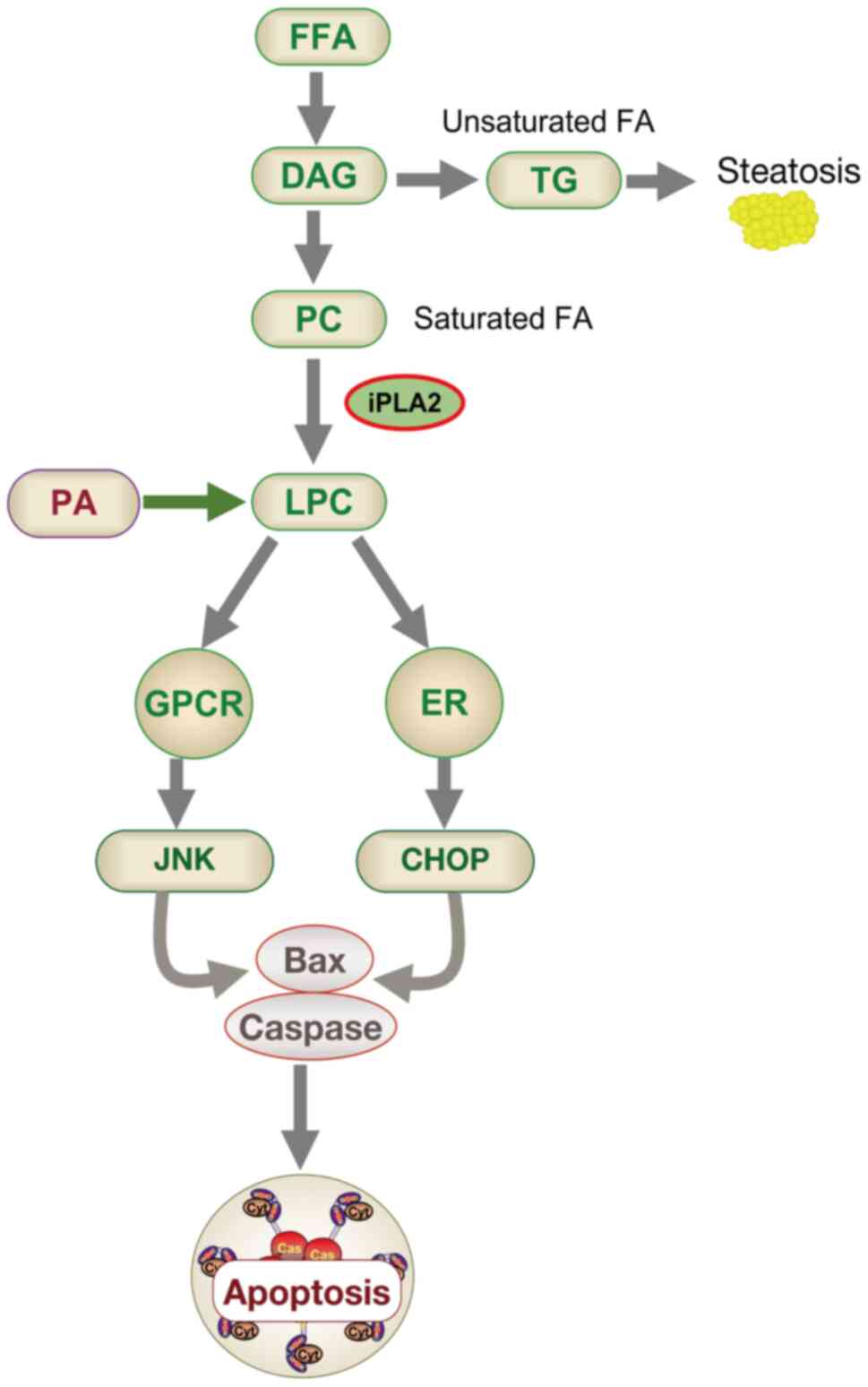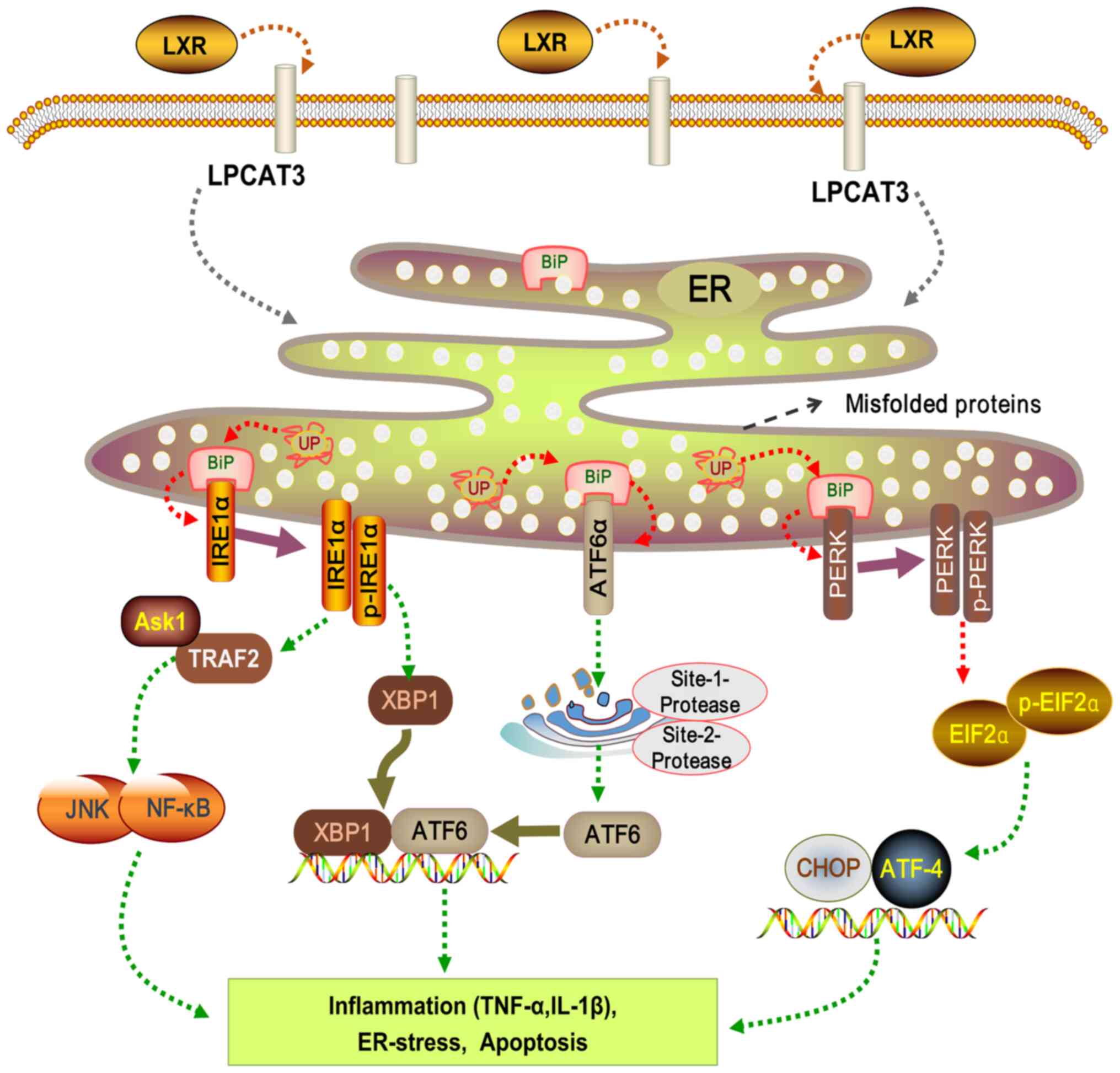|
1
|
Sanyal AJ: Past, present and future
perspectives in nonalcoholic fatty liver disease. Nat Rev
Gastroenterol Hepatol. 16:377–386. 2019.
|
|
2
|
Leow WQ, Chan AW, Mendoza PGL, Lo R, Yap K
and Kim H: Non-alcoholic fatty liver disease: The pathologist's
perspective. Clin Mol Hepatol. 29(Suppl): S302–S318. 2023.
|
|
3
|
Fan JG, Wei L and Zhuang H; National
Workshop on Fatty Liver and Alcoholic Liver Disease, Chinese
Society of Hepatology, Chinese Medical Association; Fatty Liver
Disease Expert Committee, Chinese Medical Doctor Association:
Guidelines of prevention and treatment for nonalcoholic fatty liver
disease (2018, China). J Dig Dis. 20:163–173. 2019.
|
|
4
|
Zhou J, Zhou F, Wang W, Zhang XJ, Ji YX,
Zhang P, She ZG, Zhu L, Cai J and Li H: Epidemiological Features of
NAFLD From 1999 to 2018 in China. Hepatology. 71:1851–1864.
2020.
|
|
5
|
Younossi Z, Anstee QM, Marietti M, Hardy
T, Henry L, Eslam M, George J and Bugianesi E: Global burden of
NAFLD and NASH: Trends, predictions, risk factors and prevention.
Nat Rev Gastroenterol Hepatol. 15:11–20. 2018.
|
|
6
|
Raza S, Rajak S, Upadhyay A, Tewari A and
Anthony Sinha R: Current treatment paradigms and emerging therapies
for NAFLD/NASH. Front Biosci (Landmark Ed). 26:206–237. 2021.
|
|
7
|
Meroni M, Longo M, Rustichelli A and
Dongiovanni P: Nutrition and Genetics in NAFLD: The Perfect
Binomium. Int J Mol Sci. 21:29862020.
|
|
8
|
Papatheodoridi M and Cholongitas E:
Diagnosis of non-alcoholic fatty liver disease (NAFLD): Current
concepts. Curr Pharm Des. 24:4574–4586. 2018.
|
|
9
|
Safari Z and Gérard P: The links between
the gut microbiome and non-alcoholic fatty liver disease (NAFLD).
Cell Mol Life Sci. 76:1541–1558. 2019.
|
|
10
|
Buzzetti E, Pinzani M and Tsochatzis EA:
The multiple-hit pathogenesis of non-alcoholic fatty liver disease
(NAFLD). Metabolism. 65:1038–1048. 2016.
|
|
11
|
Polyzos SA, Kountouras J, Zavos C and
Deretzi G: Nonalcoholic fatty liver disease: Multimodal treatment
options for a pathogenetically multiple-hit disease. J Clin
Gastroenterol. 46:272–284. 2012.
|
|
12
|
Karkucinska-Wieckowska A, Simoes ICM,
Kalinowski P, Lebiedzinska-Arciszewska M, Zieniewicz K, Milkiewicz
P, Górska-Ponikowska M, Pinton P, Malik AN, Krawczyk M, et al:
Mitochondria, oxidative stress and nonalcoholic fatty liver
disease: A complex relationship. Eur J Clin Invest.
52:e136222022.
|
|
13
|
Tilg H, Adolph TE, Dudek M and Knolle P:
Non-alcoholic fatty liver disease: The interplay between
metabolism, microbes and immunity. Nat Metab. 3:1596–1607.
2021.
|
|
14
|
Albillos A, de Gottardi A and Rescigno M:
The gut-liver axis in liver disease: Pathophysiological basis for
therapy. J Hepatol. 72:558–577. 2020.
|
|
15
|
Filipovic B, Lukic S, Mijac D,
Marjanovic-Haljilji M, Vojnovic M, Bogdanovic J, Glisic T,
Filipovic N, Al Kiswani J, Djokovic A, et al: The new therapeutic
approaches in the treatment of non-alcoholic fatty liver disease.
Int J Mol Sci. 22:132192021.
|
|
16
|
Singh S, Osna NA and Kharbanda KK:
Treatment options for alcoholic and non-alcoholic fatty liver
disease: A review. World J Gastroenterol. 23:6549–6570. 2017.
|
|
17
|
Townsend SA and Newsome PN: Review
article: New treatments in non-alcoholic fatty liver disease.
Aliment Pharmacol Ther. 46:494–507. 2017.
|
|
18
|
Albhaisi SAM and Sanyal AJ: New drugs for
NASH. Liver Int. 41(Suppl 1): S112–S118. 2021.
|
|
19
|
Gofton C and George J: Updates in fatty
liver disease: Pathophysiology, diagnosis and management. Aust J
Gen Pract. 50:702–707. 2021.
|
|
20
|
Klińska S, Jasieniecka-Gazarkiewicz K and
Banaś A: Acyl-CoA: lysophosphatidylcholine acyltransferases
(LPCATs) of Camelina sativa seeds: Biochemical properties and
function. Planta. 250:1655–1670. 2019.
|
|
21
|
Zhang Q, Yao D, Rao B, Jian L, Chen Y, Hu
K, Xia Y, Li S, Shen Y, Qin A, et al: The structural basis for the
phospholipid remodeling by lysophosphatidylcholine acyltransferase
3. Nat Commun. 12:68692021.
|
|
22
|
Law SH, Chan ML, Marathe GK, Parveen F,
Chen CH and Ke LY: An updated review of lysophosphatidylcholine
metabolism in human diseases. Int J Mol Sci. 20:11492019.
|
|
23
|
Shao G, Qian Y, Lu L, Liu Y, Wu T, Ji G
and Xu H: Research progress in the role and mechanism of LPCAT3 in
metabolic related diseases and cancer. J Cancer. 13:2430–2439.
2022.
|
|
24
|
Wang B and Tontonoz P: Phospholipid
remodeling in physiology and disease. Annu Rev Physiol. 81:165–188.
2019.
|
|
25
|
Hong C and Tontonoz P: Liver X receptors
in lipid metabolism: Opportunities for drug discovery. Nat Rev Drug
Discov. 13:433–444. 2014.
|
|
26
|
Rong X, Albert CJ, Hong C, Duerr MA,
Chamberlain BT, Tarling EJ, Ito A, Gao J, Wang B, Edwards PA, et
al: LXRs regulate ER stress and inflammation through dynamic
modulation of membrane phospholipid composition. Cell Metab.
18:685–697. 2013.
|
|
27
|
Morita SY and Ikeda Y: Regulation of
membrane phospholipid biosynthesis in mammalian cells. Biochem
Pharmacol. 206:1152962022.
|
|
28
|
Vance JE: Phospholipid synthesis and
transport in mammalian cells. Traffic. 16:1–18. 2015.
|
|
29
|
Patton-Vogt J and de Kroon AIPM:
Phospholipid turnover and acyl chain remodeling in the yeast ER.
Biochim Biophys Acta Mol Cell Biol Lipids. 1865:1584622020.
|
|
30
|
Vance DE: Phospholipid methylation in
mammals: From biochemistry to physiological function. Biochim
Biophys Acta. 1838:1477–1487. 2014.
|
|
31
|
Kennedy EP and Weiss SB: The function of
cytidine coenzymes in the biosynthesis of phospholipides. J Biol
Chem. 222:193–214. 1956.
|
|
32
|
Kennedy EP: Biosynthesis of
phospholipides. Fed Proc. 16:847–853. 1957.
|
|
33
|
Lands WE: Stories about acyl chains.
Biochim Biophys Acta. 1483:1–14. 2000.
|
|
34
|
Dahlman I, Nilsson M, Jiao H, Hoffstedt J,
Lindgren CM, Humphreys K, Kere J, Gustafsson JA, Arner P and
Dahlman-Wright K: Liver X receptor gene polymorphisms and adipose
tissue expression levels in obesity. Pharmacogenet Genomics.
16:881–889. 2006.
|
|
35
|
Han M, Liang L, Liu LR, Yue J, Zhao YL and
Xiao HP: Liver X receptor gene polymorphisms in tuberculosis:
Effect on susceptibility. PLoS One. 9:e959542014.
|
|
36
|
Yu M, Geiger B, Deeb N and Rothschild MF:
Liver X receptor alpha and beta genes have the potential role on
loin lean and fat content in pigs. J Anim Breed Genet. 123:81–88.
2006.
|
|
37
|
Yonezawa S, Abe M, Kawasaki Y, Natori Y
and Sugiyama A: Each liver X receptor (LXR) type has a different
purpose in different situations. Biochem Biophys Res Commun.
508:92–96. 2019.
|
|
38
|
Ducheix S, Lobaccaro JM, Martin PG and
Guillou H: Liver X Receptor: An oxysterol sensor and a major player
in the control of lipogenesis. Chem Phys Lipids. 164:500–514.
2011.
|
|
39
|
Bilotta MT, Petillo S, Santoni A and
Cippitelli M: Liver X Receptors: Regulators of cholesterol
metabolism, inflammation, autoimmunity, and cancer. Front Immunol.
11:5843032020.
|
|
40
|
Cave MC, Clair HB, Hardesty JE, Falkner
KC, Feng W, Clark BJ, Sidey J, Shi H, Aqel BA, McClain CJ and
Prough RA: Nuclear receptors and nonalcoholic fatty liver disease.
Biochim Biophys Acta. 1859:1083–1099. 2016.
|
|
41
|
Wang B and Tontonoz P: Liver X receptors
in lipid signalling and membrane homeostasis. Nat Rev Endocrinol.
14:452–463. 2018.
|
|
42
|
Goodwin BJ, Zuercher WJ and Collins JL:
Recent advances in liver X receptor biology and chemistry. Curr Top
Med Chem. 8:781–791. 2008.
|
|
43
|
Russo-Savage L and Schulman IG: Liver X
receptors and liver physiology. Biochim Biophys Acta Mol Basis Dis.
1867:1661212021.
|
|
44
|
Hamilton JP, Koganti L, Muchenditsi A,
Pendyala VS, Huso D, Hankin J, Murphy RC, Huster D, Merle U,
Mangels C, et al: Activation of liver X receptor/retinoid X
receptor pathway ameliorates liver disease in Atp7B(-/-) (Wilson
disease) mice. Hepatology. 63:1828–1841. 2016.
|
|
45
|
Schulman IG: Liver X receptors link lipid
metabolism and inflammation. FEBS Lett. 591:2978–2991. 2017.
|
|
46
|
Endo-Umeda K and Makishima M: Liver X
receptors regulate cholesterol metabolism and immunity in hepatic
nonparenchymal cells. Int J Mol Sci. 20:50452019.
|
|
47
|
Higuchi N, Kato M, Shundo Y, Tajiri H,
Tanaka M, Yamashita N, Kohjima M, Kotoh K, Nakamuta M, Takayanagi R
and Enjoji M: Liver X receptor in cooperation with SREBP-1c is a
major lipid synthesis regulator in nonalcoholic fatty liver
disease. Hepatol Res. 38:1122–1129. 2008.
|
|
48
|
Chen G, Liang G, Ou J, Goldstein JL and
Brown MS: Central role for liver X receptor in insulin-mediated
activation of Srebp-1c transcription and stimulation of fatty acid
synthesis in liver. Proc Natl Acad Sci USA. 101:11245–11250.
2004.
|
|
49
|
Lu Y, Shao M, Xiang H, Wang J, Ji G and Wu
T: Qinggan huoxue recipe alleviates alcoholic liver injury by
suppressing endoplasmic reticulum stress through LXR-LPCAT3. Front
Pharmacol. 13:8241852022.
|
|
50
|
Okazaki H, Goldstein JL, Brown MS and
Liang G: LXR-SREBP-1c-phospholipid transfer protein axis controls
very low density lipoprotein (VLDL) particle size. J Biol Chem.
285:6801–6810. 2010.
|
|
51
|
Vance DE: Role of phosphatidylcholine
biosynthesis in the regulation of lipoprotein homeostasis. Curr
Opin Lipidol. 19:229–234. 2008.
|
|
52
|
Rong X, Wang B, Dunham MM, Hedde PN, Wong
JS, Gratton E, Young SG, Ford DA and Tontonoz P: Lpcat3-dependent
production of arachidonoyl phospholipids is a key determinant of
triglyceride secretion. Elife. 4:e065572015.
|
|
53
|
Hashidate-Yoshida T, Harayama T, Hishikawa
D, Morimoto R, Hamano F, Tokuoka SM, Eto M, Tamura-Nakano M,
Yanobu-Takanashi R, Mukumoto Y, et al: Fatty acid remodeling by
LPCAT3 enriches arachidonate in phospholipid membranes and
regulates triglyceride transport. Elife. 4:e063282015.
|
|
54
|
Li Z, Jiang H, Ding T, Lou C, Bui HH, Kuo
MS and Jiang XC: Deficiency in lysophosphatidylcholine
acyltransferase 3 reduces plasma levels of lipids by reducing lipid
absorption in mice. Gastroenterology. 149:1519–1529. 2015.
|
|
55
|
Rong X, Wang B, Palladino EN, de Aguiar
Vallim TQ, Ford DA and Tontonoz P: ER phospholipid composition
modulates lipogenesis during feeding and in obesity. J Clin Invest.
127:3640–3651. 2017.
|
|
56
|
Anderson CD, Upadhya G, Conzen KD, Jia J,
Brunt EM, Tiriveedhi V, Xie Y, Ramachandran S, Mohanakumar T,
Davidson NO and Chapman WC: Endoplasmic reticulum stress is a
mediator of posttransplant injury in severely steatotic liver
allografts. Liver Transpl. 17:189–200. 2011.
|
|
57
|
Hishikawa D, Shindou H, Kobayashi S,
Nakanishi H, Taguchi R and Shimizu T: Discovery of a
lysophospholipid acyltransferase family essential for membrane
asymmetry and diversity. Proc Natl Acad Sci USA. 105:2830–2835.
2008.
|
|
58
|
Valentine WJ, Yanagida K, Kawana H, Kono
N, Noda NN, Aoki J and Shindou H: Update and nomenclature proposal
for mammalian lysophospholipid acyltransferases, which create
membrane phospholipid diversity. J Biol Chem. 298:1014702022.
|
|
59
|
Shindou H, Hishikawa D, Harayama T, Eto M
and Shimizu T: Generation of membrane diversity by lysophospholipid
acyltransferases. J Biochem. 154:21–28. 2013.
|
|
60
|
Matsuda S, Inoue T, Lee HC, Kono N, Tanaka
F, Gengyo-Ando K, Mitani S and Arai H: Member of the membrane-bound
O-acyltransferase (MBOAT) family encodes a lysophospholipid
acyltransferase with broad substrate specificity. Genes Cells.
13:879–888. 2008.
|
|
61
|
Gross B, Pawlak M, Lefebvre P and Staels
B: PPARs in obesity-induced T2DM, dyslipidaemia and NAFLD. Nat Rev
Endocrinol. 13:36–49. 2017.
|
|
62
|
Cole LK, Vance JE and Vance DE:
Phosphatidylcholine biosynthesis and lipoprotein metabolism.
Biochim Biophys Acta. 1821:754–761. 2012.
|
|
63
|
Harayama T and Riezman H: Understanding
the diversity of membrane lipid composition. Nat Rev Mol Cell Biol.
19:281–296. 2018.
|
|
64
|
Li Z, Ding T, Pan X, Li Y, Li R, Sanders
PE, Kuo MS, Hussain MM, Cao G and Jiang XC: Lysophosphatidylcholine
acyltransferase 3 knockdown-mediated liver lysophosphatidylcholine
accumulation promotes very low density lipoprotein production by
enhancing microsomal triglyceride transfer protein expression. J
Biol Chem. 287:20122–20131. 2012.
|
|
65
|
Cash JG and Hui DY: Liver-specific
overexpression of LPCAT3 reduces postprandial hyperglycemia and
improves lipoprotein metabolic profile in mice. Nutr Diabetes.
6:e2062016.
|
|
66
|
Jacobs RL, Lingrell S, Zhao Y, Francis GA
and Vance DE: Hepatic CTP:phosphocholine cytidylyltransferase-alpha
is a critical predictor of plasma high density lipoprotein and very
low density lipoprotein. J Biol Chem. 283:2147–2155. 2008.
|
|
67
|
Balla T, Sengupta N and Kim YJ: Lipid
synthesis and transport are coupled to regulate membrane lipid
dynamics in the endoplasmic reticulum. Biochim Biophys Acta Mol
Cell Biol Lipids. 1865:1584612020.
|
|
68
|
Lev S: Nonvesicular lipid transfer from
the endoplasmic reticulum. Cold Spring Harb Perspect Biol.
4:a0133002012.
|
|
69
|
Walker AK, Jacobs RL, Watts JL, Rottiers
V, Jiang K, Finnegan DM, Shioda T, Hansen M, Yang F, Niebergall LJ,
et al: A conserved SREBP-1/phosphatidylcholine feedback circuit
regulates lipogenesis in metazoans. Cell. 147:840–852. 2011.
|
|
70
|
Eto M, Shindou H, Koeberle A, Harayama T,
Yanagida K and Shimizu T: Lysophosphatidylcholine acyltransferase 3
is the key enzyme for incorporating arachidonic acid into
glycerophospholipids during adipocyte differentiation. Int J Mol
Sci. 13:16267–16280. 2012.
|
|
71
|
Feng C, Lou B, Dong J, Li Z, Chen Y, Li Y,
Zhang X, Jiang XC and Ding T: Lysophosphatidylcholine
acyltransferase 3 deficiency impairs 3T3L1 cell adipogenesis
through activating Wnt/β-catenin pathway. Biochim Biophys Acta Mol
Cell Biol Lipids. 1863:834–843. 2018.
|
|
72
|
Wang B, Rong X, Duerr MA, Hermanson DJ,
Hedde PN, Wong JS, Vallim TQ, Cravatt BF, Gratton E, Ford DA and
Tontonoz P: Intestinal phospholipid remodeling is required for
dietary-lipid uptake and survival on a high-fat diet. Cell Metab.
23:492–504. 2016.
|
|
73
|
Repa JJ, Liang G, Ou J, Bashmakov Y,
Lobaccaro JM, Shimomura I, Shan B, Brown MS, Goldstein JL and
Mangelsdorf DJ: Regulation of mouse sterol regulatory
element-binding protein-1c gene (SREBP-1c) by oxysterol receptors,
LXRalpha and LXRbeta. Genes Dev. 14:2819–2830. 2000.
|
|
74
|
Shim J, Moulson CL, Newberry EP, Lin MH,
Xie Y, Kennedy SM, Miner JH and Davidson NO: Fatty acid transport
protein 4 is dispensable for intestinal lipid absorption in mice. J
Lipid Res. 50:491–500. 2009.
|
|
75
|
Kabir I, Li Z, Bui HH, Kuo MS, Gao G and
Jiang XC: Small intestine but not liver lysophosphatidylcholine
acyltransferase 3 (Lpcat3) deficiency has a dominant effect on
plasma lipid metabolism. J Biol Chem. 291:7651–7660. 2016.
|
|
76
|
Altmann SW, Davis HR Jr, Zhu LJ, Yao X,
Hoos LM, Tetzloff G, Iyer SP, Maguire M, Golovko A, Zeng M, et al:
Niemann-Pick C1 Like 1 protein is critical for intestinal
cholesterol absorption. Science. 303:1201–1204. 2004.
|
|
77
|
Kalhan SC, Guo L, Edmison J, Dasarathy S,
McCullough AJ, Hanson RW and Milburn M: Plasma metabolomic profile
in nonalcoholic fatty liver disease. Metabolism. 60:404–413.
2011.
|
|
78
|
Brunham LR, Kruit JK, Iqbal J, Fievet C,
Timmins JM, Pape TD, Coburn BA, Bissada N, Staels B, Groen AK, et
al: Intestinal ABCA1 directly contributes to HDL biogenesis in
vivo. J Clin Invest. 116:1052–1062. 2006.
|
|
79
|
Feldstein AE, Canbay A, Angulo P, Taniai
M, Burgart LJ, Lindor KD and Gores GJ: Hepatocyte apoptosis and fas
expression are prominent features of human nonalcoholic
steatohepatitis. Gastroenterology. 125:437–443. 2003.
|
|
80
|
Akazawa Y and Nakao K: Lipotoxicity
pathways intersect in hepatocytes: Endoplasmic reticulum stress,
c-Jun N-terminal kinase-1, and death receptors. Hepatol Res.
46:977–984. 2016.
|
|
81
|
Malhi H, Bronk SF, Werneburg NW and Gores
GJ: Free fatty acids induce JNK-dependent hepatocyte lipoapoptosis.
J Biol Chem. 281:12093–12101. 2006.
|
|
82
|
Gu X, Li K, Laybutt DR, He ML, Zhao HL,
Chan JC and Xu G: Bip overexpression, but not CHOP inhibition,
attenuates fatty-acid-induced endoplasmic reticulum stress and
apoptosis in HepG2 liver cells. Life Sci. 87:724–732. 2010.
|
|
83
|
Guo W, Wong S, Xie W, Lei T and Luo Z:
Palmitate modulates intracellular signaling, induces endoplasmic
reticulum stress, and causes apoptosis in mouse 3T3-L1 and rat
primary preadipocytes. Am J Physiol Endocrinol Metab.
293:E576–E586. 2007.
|
|
84
|
Kakisaka K, Cazanave SC, Fingas CD,
Guicciardi ME, Bronk SF, Werneburg NW, Mott JL and Gores GJ:
Mechanisms of lysophosphatidylcholine-induced hepatocyte
lipoapoptosis. Am J Physiol Gastrointest Liver Physiol.
302:G77–G84. 2012.
|
|
85
|
Cohen JC, Horton JD and Hobbs HH: Human
fatty liver disease: Old questions and new insights. Science.
332:1519–1523. 2011.
|
|
86
|
Fu S, Yang L, Li P, Hofmann O, Dicker L,
Hide W, Lin X, Watkins SM, Ivanov AR and Hotamisligil GS: Aberrant
lipid metabolism disrupts calcium homeostasis causing liver
endoplasmic reticulum stress in obesity. Nature. 473:528–531.
2011.
|
|
87
|
Wu X, Zhang Y, Qiu J, Xu Y, Zhang J, Huang
J, Bai J, Huang Z, Qiu X and Xu W: Lipidomics analysis indicates
disturbed hepatocellular lipid metabolism in reynoutria
multiflora-induced idiosyncratic liver injury. Front Pharmacol.
11:5691442020.
|
|
88
|
Puri P, Baillie RA, Wiest MM, Mirshahi F,
Choudhury J, Cheung O, Sargeant C, Contos MJ and Sanyal AJ: A
lipidomic analysis of nonalcoholic fatty liver disease. Hepatology.
46:1081–1090. 2007.
|
|
89
|
Han MS, Park SY, Shinzawa K, Kim S, Chung
KW, Lee JH, Kwon CH, Lee KW, Lee JH, Park CK, et al:
Lysophosphatidylcholine as a death effector in the lipoapoptosis of
hepatocytes. J Lipid Res. 49:84–97. 2008.
|
|
90
|
Han MS, Lim YM, Quan W, Kim JR, Chung KW,
Kang M, Kim S, Park SY, Han JS, Park SY, et al:
Lysophosphatidylcholine as an effector of fatty acid-induced
insulin resistance. J Lipid Res. 52:1234–1246. 2011.
|
|
91
|
Masoodi M, Gastaldelli A, Hyötyläinen T,
Arretxe E, Alonso C, Gaggini M, Brosnan J, Anstee QM, Millet O,
Ortiz P, et al: Metabolomics and lipidomics in NAFLD: biomarkers
and non-invasive diagnostic tests. Nat Rev Gastroenterol Hepatol.
18:835–856. 2021.
|
|
92
|
Sun X, Seidman JS, Zhao P, Troutman TD,
Spann NJ, Que X, Zhou F, Liao Z, Pasillas M, Yang X, et al:
Neutralization of oxidized phospholipids ameliorates non-alcoholic
steatohepatitis. Cell Metab. 31:189–206.e8. 2020.
|
|
93
|
Wattacheril J, Seeley EH, Angel P, Chen H,
Bowen BP, Lanciault C, Caprioli RM, Abumrad N and Flynn CR:
Differential intrahepatic phospholipid zonation in simple steatosis
and nonalcoholic steatohepatitis. PLoS One. 8:e571652013.
|
|
94
|
Hall Z, Bond NJ, Ashmore T, Sanders F,
Ament Z, Wang X, Murray AJ, Bellafante E, Virtue S, Vidal-Puig A,
et al: Lipid zonation and phospholipid remodeling in nonalcoholic
fatty liver disease. Hepatology. 65:1165–1180. 2017.
|
|
95
|
Leamy AK, Egnatchik RA, Shiota M, Ivanova
PT, Myers DS, Brown HA and Young JD: Enhanced synthesis of
saturated phospholipids is associated with ER stress and
lipotoxicity in palmitate treated hepatic cells. J Lipid Res.
55:1478–1488. 2014.
|
|
96
|
Sanyal AJ, Campbell-Sargent C, Mirshahi F,
Rizzo WB, Contos MJ, Sterling RK, Luketic VA, Shiffman ML and Clore
JN: Nonalcoholic steatohepatitis: association of insulin resistance
and mitochondrial abnormalities. Gastroenterology. 120:1183–1192.
2001.
|
|
97
|
Hirsova P, Ibrabim SH, Gores GJ and Malhi
H: Lipotoxic lethal and sublethal stress signaling in hepatocytes:
Relevance to NASH pathogenesis. J Lipid Res. 57:1758–1770.
2016.
|
|
98
|
Wei Y, Wang D, Topczewski F and
Pagliassotti MJ: Saturated fatty acids induce endoplasmic reticulum
stress and apoptosis independently of ceramide in liver cells. Am J
Physiol Endocrinol Metab. 291:E275–E281. 2006.
|
|
99
|
Leamy AK, Egnatchik RA and Young JD:
Molecular mechanisms and the role of saturated fatty acids in the
progression of non-alcoholic fatty liver disease. Prog Lipid Res.
52:165–174. 2013.
|
|
100
|
Wang D, Wei Y and Pagliassotti MJ:
Saturated fatty acids promote endoplasmic reticulum stress and
liver injury in rats with hepatic steatosis. Endocrinology.
147:943–951. 2006.
|
|
101
|
Diakogiannaki E, Welters HJ and Morgan NG:
Differential regulation of the endoplasmic reticulum stress
response in pancreatic beta-cells exposed to long-chain saturated
and monounsaturated fatty acids. J Endocrinol. 197:553–563.
2008.
|
|
102
|
Borradaile NM, Han X, Harp JD, Gale SE,
Ory DS and Schaffer JE: Disruption of endoplasmic reticulum
structure and integrity in lipotoxic cell death. J Lipid Res.
47:2726–2737. 2006.
|
|
103
|
Cao SS and Kaufman RJ: Targeting
endoplasmic reticulum stress in metabolic disease. Expert Opin Ther
Targets. 17:437–448. 2013.
|
|
104
|
Senft D and Ronai ZA: UPR, autophagy, and
mitochondria crosstalk underlies the ER stress response. Trends
Biochem Sci. 40:141–148. 2015.
|
|
105
|
Hetz C: The unfolded protein response:
controlling cell fate decisions under ER stress and beyond. Nat Rev
Mol Cell Biol. 13:89–102. 2012.
|
|
106
|
Hetz C, Zhang K and Kaufman RJ:
Mechanisms, regulation and functions of the unfolded protein
response. Nat Rev Mol Cell Biol. 21:421–438. 2020.
|
|
107
|
Walter P and Ron D: The unfolded protein
response: From stress pathway to homeostatic regulation. Science.
334:1081–1086. 2011.
|
|
108
|
Wang H, Karnati S and Madhusudhan T:
Regulation of the homeostatic unfolded protein response in diabetic
nephropathy. Pharmaceuticals (Basel). 15:4012022.
|
|
109
|
Lebeaupin C, Vallée D, Hazari Y, Hetz C,
Chevet E and Bailly-Maitre B: Endoplasmic reticulum stress
signalling and the pathogenesis of non-alcoholic fatty liver
disease. J Hepatol. 69:927–947. 2018.
|
|
110
|
Hardy S, El-Assaad W, Przybytkowski E,
Joly E, Prentki M and Langelier Y: Saturated fatty acid-induced
apoptosis in MDA-MB-231 breast cancer cells. A role for
cardiolipin. J Biol Chem. 278:31861–31870. 2003.
|
|
111
|
Okere IC, Chandler MP, McElfresh TA,
Rennison JH, Sharov V, Sabbah HN, Tserng KY, Hoit BD, Ernsberger P,
Young ME and Stanley WC: Differential effects of saturated and
unsaturated fatty acid diets on cardiomyocyte apoptosis, adipose
distribution, and serum leptin. Am J Physiol Heart Circ Physiol.
291:H38–H44. 2006.
|
|
112
|
Wang J, Hu R, Yin C and Xiao Y: Tanshinone
IIA reduces palmitate-induced apoptosis via inhibition of
endoplasmic reticulum stress in HepG2 liver cells. Fundam Clin
Pharmacol. 34:249–262. 2020.
|
|
113
|
Malhi H and Gores GJ: Molecular mechanisms
of lipotoxicity in nonalcoholic fatty liver disease. Semin Liver
Dis. 28:360–369. 2008.
|
|
114
|
Listenberger LL, Han X, Lewis SE, Cases S,
Farese RV Jr, Ory DS and Schaffer JE: Triglyceride accumulation
protects against fatty acid-induced lipotoxicity. Proc Natl Acad
Sci USA. 100:3077–3082. 2003.
|
|
115
|
Ariyama H, Kono N, Matsuda S, Inoue T and
Arai H: Decrease in membrane phospholipid unsaturation induces
unfolded protein response. J Biol Chem. 285:22027–22035. 2010.
|
|
116
|
Holzer RG, Park EJ, Li N, Tran H, Chen M,
Choi C, Solinas G and Karin M: Saturated fatty acids induce c-Src
clustering within membrane subdomains, leading to JNK activation.
Cell. 147:173–184. 2011.
|
|
117
|
Ishibashi M, Varin A, Filomenko R, Lopez
T, Athias A, Gambert P, Blache D, Thomas C, Gautier T, Lagrost L
and Masson D: Liver x receptor regulates arachidonic acid
distribution and eicosanoid release in human macrophages: a key
role for lysophosphatidylcholine acyltransferase 3. Arterioscler
Thromb Vasc Biol. 33:1171–1179. 2013.
|
|
118
|
Kawamura S, Matsushita Y, Kurosaki S,
Tange M, Fujiwara N, Hayata Y, Hayakawa Y, Suzuki N, Hata M, Tsuboi
M, et al: Inhibiting SCAP/SREBP exacerbates liver injury and
carcinogenesis in murine nonalcoholic steatohepatitis. J Clin
Invest. 132:e1518952022.
|
|
119
|
Jiang H, Li Z, Huan C and Jiang XC:
Macrophage lysophosphatidylcholine acyltransferase 3
deficiency-mediated inflammation is not sufficient to induce
atherosclerosis in a mouse model. Front Cardiovasc Med.
5:1922019.
|
|
120
|
Tintle NL, Pottala JV, Lacey S,
Ramachandran V, Westra J, Rogers A, Clark J, Olthoff B, Larson M,
Harris W and Shearer GC: A genome-wide association study of
saturated, mono- and polyunsaturated red blood cell fatty acids in
the Framingham Heart Offspring Study. Prostaglandins Leukot Essent
Fatty Acids. 94:65–72. 2015.
|
|
121
|
Hishikawa D, Hashidate T, Shimizu T and
Shindou H: Diversity and function of membrane glycerophospholipids
generated by the remodeling pathway in mammalian cells. J Lipid
Res. 55:799–807. 2014.
|
|
122
|
Xiang H, Shao M, Lu Y, Wang J, Wu T and Ji
G: Kaempferol alleviates steatosis and inflammation during early
non-alcoholic steatohepatitis associated with liver X Receptor
α-Lysophosphatidylcholine acyltransferase 3 signaling pathway.
Front Pharmacol. 12:6907362021.
|
|
123
|
Kakisaka K, Suzuki Y, Fujiwara Y, Suzuki
A, Kanazawa J and Takikawa Y: Caspase-independent hepatocyte death:
A result of the decrease of lysophosphatidylcholine acyltransferase
3 in non-alcoholic steatohepatitis. J Gastroenterol Hepatol.
34:1256–1262. 2019.
|
|
124
|
Wang B, Rong X, Palladino END, Wang J,
Fogelman AM, Martín MG, Alrefai WA, Ford DA and Tontonoz P:
Phospholipid Remodeling and Cholesterol Availability Regulate
Intestinal Stemness and Tumorigenesis. Cell Stem Cell.
22:206–220.e4. 2018.
|
